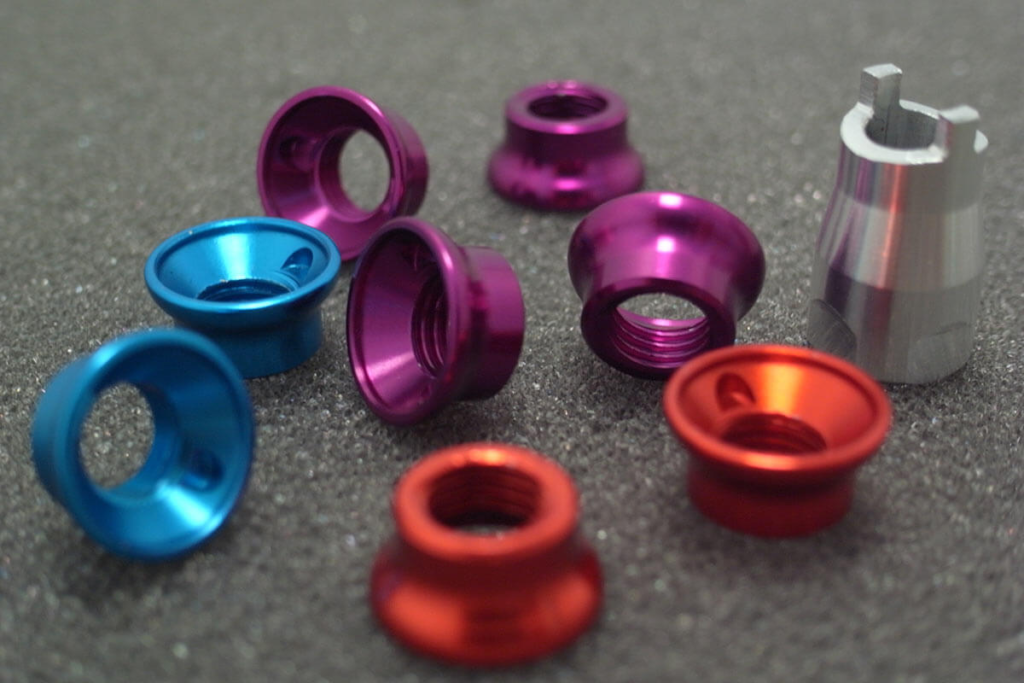
Anodizing aluminum is a process that creates a layer of aluminum oxide to protect the base metal from environmental impacts. In this article, we will explore the question “How to anodize aluminium at home?”
- How to anodize aluminium at home?
- what materials are needed to anodize aluminum at home?
- what are the steps to prepare aluminum for anodizing?
- what are the safety precautions to take when anodizing aluminum at home?
- what are the potential hazards of anodizing aluminum at home?
- what are the risks of inhaling aluminum dust during anodizing aluminum at home?
- Helpful Resources
How to anodize aluminium at home?
Here is a step-by-step guide on how to anodize aluminum at home:
1. Clean the Aluminum: Wash the aluminum with soap and water to remove dirt and debris. Rinse it thoroughly and dry it with a clean rag or paper towel.
2. Prepare the Lye Solution: Mix 3-5 tablespoons of pure lye with 1 gallon of distilled water in a plastic container. Wear a respirator and gloves when handling lye.
3. Connect the Aluminum to a Power Source: In a well-ventilated area, connect the aluminum to a power source and place it in the lye solution. Run the power to the aluminum for 45 minutes.
4. Rinse the Aluminum: Remove the aluminum from the lye solution and rinse it thoroughly with distilled water.
5. Dye the Aluminum: Place the anodized aluminum in a hot dye bath for 15 minutes to dye it. The dye is optional, but it can add color to the aluminum.
6. Seal the Aluminum: To seal the pores of the aluminum, place it in boiling distilled water for 30 minutes or use a commercial sealant.
7. Clean Up: Dispose of the lye solution and other chemicals properly. Clean the equipment and workspace thoroughly.
It is important to note that anodizing aluminum involves working with hazardous chemicals, so proper safety precautions should be taken. Wear protective gear, work in a well-ventilated area, and follow the instructions carefully.
The process may require some trial and error to achieve the desired results, but with practice, it can be a rewarding way to customize aluminum parts.
what materials are needed to anodize aluminum at home?
To anodize aluminum at home, you will need the following materials:
1. Aluminum parts: Choose small aluminum parts for anodizing, as they are easier to submerge in the acid bath.
2. Thick work clothing: Wear thick work clothing to protect yourself from the acid and other chemicals.
3. Rubber gloves: Use rubber gloves to handle the aluminum parts and chemicals.
4. Safety glasses: Wear safety glasses to protect your eyes from splashes and splatters.
5. Thick plastic tub: Use a thick plastic tub to submerge your aluminum parts in the acid bath.
6. Mild soap: Use mild soap to clean the aluminum parts before anodizing.
7. Distilled water: Use distilled water to dilute the acid and create the anodizing solution.
8. Lye: Purchase pure lye to create the anodizing solution.
9. Dye (optional): If you want to color the aluminum, purchase a fabric dye or a special dye for anodizing.
10. Sealant (optional): To seal the pores of the aluminum, you can use a commercial sealant or a cooking thermometer to check the temperature of the sealing process.
11. Agitator (optional): An agitator can be used to stir the acid bath and ensure even anodizing.
12. Scotch-Brite pads (optional): Use Scotch-Brite pads to clean the aluminum parts before anodizing.
13. Ping pong balls (optional): Place ping pong balls in the acid bath to prevent acid mist.
14. Cheap tea kettle: Use a cheap tea kettle to heat the dye.
15. Fish tank heater: Use a fish tank heater to regulate the temperature of the anodizing solution.
16. Cooking thermometer: Use a cooking thermometer to check the temperature of the anodizing solution.
Remember to work in a well-ventilated area and follow safety precautions when handling the chemicals and equipment.
what are the steps to prepare aluminum for anodizing?
To prepare aluminum for anodizing at home, you will need to follow these general steps:
1. Collect Aluminum Parts: Obtain small aluminum parts for anodizing. Small parts are easier to handle and submerge in the anodizing solution.
2. Clean the Aluminum: Wash the aluminum parts with soap and water to remove dirt and debris. Rinse them thoroughly and dry them with a clean rag or paper towel.
3. Degrease the Aluminum: Use a degreaser to ensure the aluminum is free from any oils or contaminants that could affect the anodizing process.
4. Connect the Aluminum to a Power Source: In a well-ventilated area, connect the aluminum parts to a power source and place them in the anodizing container. The aluminum will function as the anode in the anodizing process.
5. Prepare the Anodizing Solution: Create the anodizing bath by adding sulfuric acid to distilled water in the anodizing container. The ratio is typically 1 part acid to 3 parts water.
6. Run the Anodizing Process: Run the power to the aluminum parts for the specified duration, usually around 45 minutes, to allow the anodizing process to take place.
7. Rinse the Anodized Aluminum: Remove the anodized aluminum parts from the anodizing solution and rinse them thoroughly with distilled water to remove any residual acid.
8. Optional: Dye the Aluminum: If desired, place the anodized aluminum parts in a hot dye bath for around 15 minutes to add color. This step is optional but can enhance the appearance of the anodized parts.
9. Seal the Anodized Aluminum: To seal the anodized layer and improve its corrosion resistance, place the parts in boiling distilled water for around 30 minutes or use a commercial sealant.
It’s important to note that anodizing aluminum involves working with hazardous chemicals, so proper safety precautions should be taken. Wear protective gear, work in a well-ventilated area, and follow the instructions carefully.
The process may require some trial and error to achieve the desired results, but with practice, it can be a rewarding way to customize aluminum parts.
what are the safety precautions to take when anodizing aluminum at home?
When anodizing aluminum at home, it is essential to take the following safety precautions:
1. Personal Protective Equipment (PPE): Wear thick work clothing, rubber gloves, and safety glasses to protect your skin and eyes from chemical splashes and spills.
2. Respiratory Protection: Use a respirator or work in a well-ventilated area to avoid inhaling fumes or mists from the anodizing solutions.
3. Handle Chemicals Safely: Take extra precautions when handling caustic substances like lye and sulfuric acid, as they can cause chemical burns if handled incorrectly. Always wear gloves and work in a well-ventilated area when using these chemicals.
4. Distilled Water: Use distilled water in the anodizing process to ensure the quality and consistency of the anodized aluminum parts. Avoid using tap water, as it may contain impurities that can affect the anodizing process.
5. Dispose of Chemicals Properly: Dispose of the anodizing solutions and other chemicals properly, following local regulations and guidelines for hazardous waste disposal.
6. Optional Safety Equipment: Consider using additional safety equipment, such as an agitator for the acid bath, Scotch-Brite pads for cleaning parts before anodizing, and ping pong balls to prevent acid mist. These items can help make the anodizing process safer and more efficient.
By following these safety precautions, you can minimize the risks associated with anodizing aluminum at home and ensure a safe and successful anodizing process.
what are the potential hazards of anodizing aluminum at home?
The potential hazards of anodizing aluminum at home include:
1. Chemical Burns: The use of caustic substances such as lye and sulfuric acid can cause chemical burns if handled incorrectly. It is essential to take extra precautions when working with these chemicals, including wearing appropriate personal protective equipment (PPE).
2. Inhalation Risks: When anodizing aluminum, there is a risk of inhaling fumes or mists from the anodizing solutions. Working in a well-ventilated area and using a respirator can help minimize the risk of inhaling hazardous substances.
3. Skin and Eye Irritation: Contact with anodizing solutions, lye, or sulfuric acid can cause skin and eye irritation. It is important to wear rubber gloves, safety glasses, and other PPE to protect against these risks.
4. Ingestion Risks: Accidental ingestion of anodizing solutions or chemicals can lead to serious health consequences. It is crucial to handle these substances with care and ensure they are stored safely and out of reach of children and pets.
5. Aluminum Dust: When grinding anodized aluminum, there is a risk of inhaling aluminum dust, which can be harmful. Using a dust collector, respirator, or wet grinding method can help minimize the risk of exposure to aluminum dust.
By being aware of these potential hazards and taking appropriate safety precautions, such as using PPE, working in a well-ventilated area, and handling chemicals safely, the risks associated with anodizing aluminum at home can be minimized.
what are the risks of inhaling aluminum dust during anodizing aluminum at home?
Inhaling aluminum dust during anodizing aluminum at home can lead to respiratory issues such as irritation in the nose, throat, and lungs. It can also cause coughing and shortness of breath.
Aluminum dust can cause scarring of the lungs (pulmonary fibrosis) with symptoms of cough and shortness of breath. The inhalation of beryllium dust, mist, or fume can cause a serious lung condition in some individuals.
To minimize the risk of inhaling aluminum dust, it is recommended to use a dust collector, respirator, or wet grinding method when grinding anodized aluminum. It is also important to work in a well-ventilated area and avoid inhaling fumes or mists from the anodizing solutions.
By taking appropriate safety precautions, such as using PPE, working in a well-ventilated area, and handling chemicals safely, the risks associated with inhaling aluminum dust during anodizing aluminum at home can be minimized.
Helpful Resources
- https://www.wikihow.com/Anodize-Aluminum
- https://makeitfrommetal.com/how-to-anodize-aluminum-at-home/
- https://sendcutsend.com/blog/diy-anodizing-in-10-steps/
- https://www.tfgusa.com/how-to-anodize-aluminum/
- https://www.finishing.com/381/64.shtml
- https://www.physicsforums.com/threads/health-effects-of-inhaling-anodized-aluminium.171970/
- https://www.finishing.com/535/56.shtml
- https://www.nj.gov/health/eoh/rtkweb/documents/fs/0054.pdf
- https://materion.com/-/media/files/corporate/besafetyfacts/sf501-safetypracticesforworkingwithalbemet.pdf
- https://thecorrecter.com/how-to-artificially-age-aluminium/
- https://thecorrecter.com/how-to-darken-aluminium/
- https://thecorrecter.com/do-aluminium-boats-need-anodes/
- https://thecorrecter.com/does-aluminium-corrode-in-water/
- https://thecorrecter.com/how-to-remove-oxidation-from-aluminium-engine/
- https://thecorrecter.com/how-to-stop-electrolysis-on-aluminium-boat/
- https://thecorrecter.com/how-to-stop-corrosion-on-aluminium-boats/
- https://thecorrecter.com/does-aluminium-oxidize/
- https://thecorrecter.com/how-to-fix-aluminium-window-hinges/
- https://thecorrecter.com/how-to-insulate-aluminium-window-frames/
- https://thecorrecter.com/can-aluminium-be-brazed/
- https://thecorrecter.com/how-to-stop-condensation-on-aluminium-window-frames/
- https://thecorrecter.com/how-to-melt-aluminium-without-a-foundry/
- https://thecorrecter.com/is-aluminium-dust-harmful/
- https://thecorrecter.com/is-aluminium-oxide-ionic-or-covalent/
- https://thecorrecter.com/is-aluminium-foil-a-good-insulator-of-heat/
- https://thecorrecter.com/is-aluminium-monatomic-or-diatomic/
- https://thecorrecter.com/can-aluminium-be-magnetised/
- https://thecorrecter.com/is-aluminium-toxicity-reversible/
- https://thecorrecter.com/what-to-do-if-you-accidentally-eat-aluminum-foil/
- https://thecorrecter.com/can-you-put-aluminium-foil-in-an-air-fryer/
- https://thecorrecter.com/what-size-aluminium-wire-for-125-amp-service/
